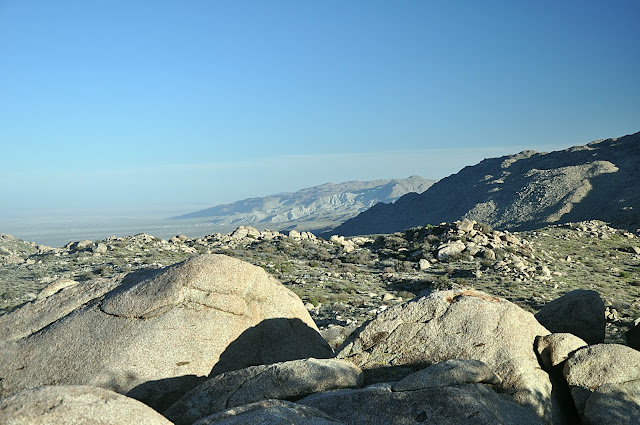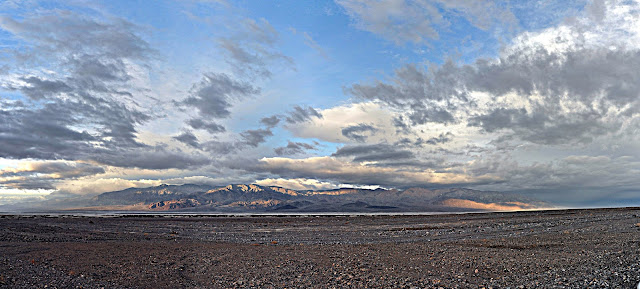 |
| Early morning rainbow at Culp Valley Campground. The rain never made it into the valley. |
Our friends, Liz and Jack, told us that we should visit Anza-Borrego Desert State Park in Southern California. Since we wanted to continue west to El Cajon, California and meet up with a friend I've known since childhood and the park was on the way we decided to make it our next destination. The route we chose to depart Death Valley took us west on state route 190 to the Panamint Valley and then state route 178 south. We hit a stretch of resurfacing on this road that presented us with four miles of the worst washboard we have yet to experience. The fastest we could travel was seven or eight miles per hour.
Since it was Super Bowl weekend we wanted to be in a town with a good sports bar. We decided to boondock on BLM Off Highway Recreational Vehicle Area just 15 minutes from Ridgecrest, CA. Ridgecrest is at the gate to the U.S. Navy's China Lake Weapons Testing Grounds. My research told me that the Navy put a lot of effort into attracting highly educated and skilled scientists and technicians to such an isolated and harsh place. The efforts apparently paid off because the town is rather charming with nice restaurants and shopping. Unlike most "military towns", the main street leading to the base was not a series of pawn shops, predatory lenders and "gentleman's clubs". Rather their were nice restaurants and shops.
 |
| Off Highway Vehicle recreation site, southeast of Ridgecrest, CA |
We watched the superbowl at Schooners Patio Grille where the walls were lined with large televisions providing excellent viewing for everyone. Sitting beside us were two British Airmen who appreciated our assistance understanding the rules of the game. The crowd was about evenly split about whom they were cheering for. And, despite several patrons who had obviously not paced themselves in the amount of alcohol they were consuming, the crowd was generally well behaved.
Sarah and I celebrated Fat Tuesday at a fine French Restaurant, Mon Reve. The restaurant is small and unpretentious offering a small menu of French country cuisine by a very charming owner, Herve. Hevre waits on the tables and his wife does the cooking. Unfortunately, we didn't get to meet the chef.
Our next stop along the way to Anza-Borrego was at the Applewood Campground in the San Bernadino National Forest just north of San Bernadino. We were saddened to see that this campground is inhabited by homeless people, some of whom had automobiles and others that did not. The campground is rundown, ill-kept with vandalism to the park buildings and grounds. At other campgrounds near metropolitan areas we have experienced the occasional camper we suspected was homeless. The clues are not so subtle, they often have older rundown cars and makeshift camping equipment and they avoid even the simplest social contact. We stayed the night and moved on to Dripping Springs State Park. Being that it was Washington's Birthday and thus a long holiday weekend, we were lucky to get a campsite on a Thursday afternoon before the park filled up. We stayed four nights and enjoyed the hikes that led us high into the hills overlooking Temeculah, California. Temeculah is just a 20 minute drive from the campground. It is an upscale small city with good shopping available, Sarah found a Trader Joe's, and a beautiful library that we took advantage of for good internet connectivity. A drive through Old Town confirmed for us that we were in Southern California. On the warm and sunny Sunday afternoon, everyone in the county seemed to have descended on the small shopping and dining district.
With the weekend crowds thinned out, we headed for Anza-Borrego Desert State Park. This is a huge park surrounding the town of Borrego Springs. The weather was exceptionally warm, upper 80s to lower 90s in the valley, so we chose to stay at the Culp Valley Primitive campground that is 3,000 feet higher and 10-15 degrees cooler. The campground is primitive in that there are a few rutted roads meandering through a relatively level open area among the huge gneis boulders with haphazardly situated places where one could get off the road and place a tent or RV. Other than a vault toilet, there are no services. Our campsite backed up to a level area among the boulders with a commanding view of the valley to the east where we ritually watched the colors change each evening at sunset.
 |
| Looking east from Culp Valley near sunset. |
 |
| Our neighbors watching the moon rise from Culp Valley |
Anza-Borrego is home to a small and threatened herd of Bighorn Sheep, Borrego in Spanish, and nearly limitless places to hike and explore the washes, canyons and peaks of the park. The rangers and volunteers offer a surprising variety of guided hikes educating visitors about the geology, ecology and history of the area. Sarah and I especially enjoyed hiking trails that led to seasonal springs and the oasis they provide in this desert. Unlike Death Valley, the El Nino rains had missed Anza-Borrego so the wildflowers were not as magnificent. Here we had to slow down and look closely to see the beauty and diversity of each section of this desert. It reinforced, for us, that from the window of a speeding automobile it is impossible to appreciate the full beauty of a desert. We were told that a small flock of sheep had been seen regularly just a mile or so from the campground at Palm Canyon. Indeed, they we were easy to find. The five sheep seemed completely indifferent to the dozen or so people who quietly watched and took photos of these beautiful creatures.
 |
| This ram didn't seem to mind having his picture taken. |
 |
| Hiking in the Slot. A deep narrow canyon. |
 |
| Entrance to The Slot |
The town of Borrego-Springs has several restaurants, hotels, RV parks and shops. Once again we took advantage of the public library that provided nice benches with electrical outlets for those of us who needed internet connectivity.
 |
| Sculpture Garden in Borrego Springs |
 |
| The Agave blooms once, then dies. |
 |
| The bees love Agave |
Discovering water in the desert is magical. The presence of water creates oasis where the flora changes dramatically in just a few yards. The heat of the desert vanishes as cool breezes envelope you. A hike in the desert that culminates with a waterfall is a magical experience.
 |
| The presence of broad leaf deciduous trees as well as the palm trees told us that water was ahead. |
 |
| Maidenhead Falls in Hellhole Canyon. |
Among those who tow campers there is an ongoing debate about the necessity of 4WD for one's tow vehicle (TV). Sarah and I have concluded that 4WD is a wonderful luxury, if not a requirement for our purposes. While I can only think of three times in the thousands of miles we have traveled that we needed 4WD capability to tow the trailer, having the option has allowed us to explore many places we simply could not have without it. The drive into Coyote and Sheep Canyon cemented that belief in our minds. The drive into Coyote Canyon to Sheep Canyon involved driving through soft and deep sand, crossing a stream three times, and climbing up narrow rock strewn washes. Even still, we could not go where the short wheel bed vehicles could go, forcing us to hike eight miles round trip find the oasis in Sheep Canyon.
 |
| We enjoyed the cool water in Sheep Canyon |
After eight days at Culp Valley we made short drive to Cleveland National Forest. Our intention was to stay at Cuyamaca State Park's southernmost campground. However, the information I received from the ReserveAmerica person I spoke with that the Green Valley campground was open and reservations were not required was incorrect. The campground was closed until April 1. However, we found the Oakzanita Springs Thousand Trails campground just a couple miles away. Despite our preference to stay in State or National Parks we pulled in and signed up for two nights because our purpose for being in this area was to visit a lifelong friend and his wife who live in El Cajon. We were warmly welcomed to the campground by the gate attendant. He cheerfully drove us around the park helping us pick which site we wanted. While most of the sites are small, and not all have full hookups, we found a nice spot big enough to fit our 31' trailer and still have room to park the TV in front. Like so many other commercial parks we have visited, this one seems to have significant population of people who are living in travel trailers. Clearly, many of the motorhomes and trailers, though well maintained, haven't moved in a long time. But it is quiet and would serve our purposes. Sarah took advantage of the clean laundry facilities and we enjoyed having the large hot tub that evening completely to ourselves in the full moon's light. The town of Alpine, just 20 minutes away, has good grocery stores, restaurants and shopping.
We returned to Anza-Borrego two days later. This time we camped at Mountain Desert Springs primitive campground about 25 miles south of Culp Valley. This campground easily accommodates trailers and motor homes. It is located on large, flat and open land at the entrance to a canyon with several springs and groups of the California Fan Palms. From here we were able to explore the Vallecito Badlands and enjoy the refreshing hot springs and swimming pools at Aqua Caliente that is just eight miles to the west. From Agua Caliente there is a nice loop trail into Moonlight Canyon that ascends from the springs to the head of the canyon then drops down into a canyon to the east before circling around and returning to Agua Caliente. There are two attractive side canyons begging to be explored, but they were closed due to a mountain lion having recently made a kill in the area.
 |
Understanding the meaning of "Badlands"
From a distance it appears to be flat, but up close, BAD. |
Our last morning at Mountain Desert Springs, we took one final hike into the canyon, past the springs and over a ridge to the west. On this south facing slope we discovered a few Beavertail cacti in bloom. We had been watching the buds on these cacti growing bigger by the day and we were delighted to have finally seen them in bloom. Just as we finished enjoying these flowers I noticed movement high up the steep slope. Here we watched a solitary ram come down towards us. He stopped and pondered us for a while then slowly passed us just 25 yards away. While not as majestic a creature, we also enjoyed seeing another desert dweller whose existence was evident everywhere, but we had never seen before, the desert packrat. He quickly skittered away up the slope, seemingly much more nervous than the the ram. What a perfect ending to our stay at Anza-Borrego Desert State Park.
 |
| Some of the barrel cacti are blooming |
 |
| Beavertail finally in bloom |
 |
| Worth the wait |
 |
| I think this ram was posing for me |
After almost three months on the road, it is time to begin our meander back to Massachusetts. We have set a goal of being home by April first.
Stay tuned























